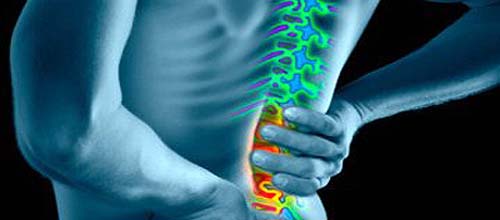
Most of the population suffers from back pain at some point in their lives. In spite of this common occurrence, most people are completely unaware of the things they do that contribute to this problem.
Low back problems affect the spine’s flexibility, stability, and strength, which can cause pain, discomfort, and stiffness. Low back pain is often triggered by some combination of overuse, muscle strain, or injury to the muscles and ligaments that support the spine. Less commonly, low back pain is caused by illness or spinal deformity.
Back pain can be : Acute, lasting less than 3 months. Most people gain relief after 4 to 6 weeks of home treatment. Recurrent, a repeat episode of acute symptoms. Most people have at least one episode of recurrent low back pain. Chronic, lasting longer than 3 months.
Causes
The main causes of backache are muscular tension, joint strain, poor posture and incorrect nutrition resulting from dietetic errors and lack of exercise. Low back pain is usually caused by strain from lifting, twisting, or bending. However, some low back pain can be a symptom of a more serious condition, such as an infection, a rheumatic or arthritic condition, or ovarian cysts. Today, a high proportion of people spend the better part of their working day sitting at desks, at work stations, or in cars and trucks. These changes in human behavior have had a profound-and largely negative- impact on human physiology.
It is now believed that the leading cause of back pain is simple muscle strain. Symptoms may come on suddenly and can be acutely painful; but back pain, in actuality, develops over a long period of time. When muscles contract, lactic acid and pyruvic acid are produced as byproducts of muscular activity. It is the lactic acid in the muscles that produces the sensation of muscle fatigue following strenuous activity. If high levels of these acidic byproducts accumulate in the muscles, they cause irritation that can eventually turn into pain and interfere with the normal conduction of electrical impulses in the muscle tissue. This results in a phenomenon called delayed-onset muscle soreness (DOMS). Problems with acidic buildup are often made worse by dehydration.
Prevention
Most people spend long hours sitting. Make sure your chair correctly supports your body, When you have to lift heavy objects, don’t bend at the waist. Learn the correct technique to lift, Don’t prop your head and neck on a big pillow. Instead, choose one that keeps your head and neck in line with your upper back, Maintain a healthy weight to avoid excess strain on your lower back, Exercise programs that include aerobic conditioning and strengthening exercises can help reduce the recurrence of low back pain.
Diet and Other Tips
Reduce your consumption of vata-increasing foods. Avoid most beans, including black beans, pinto beans, adzuki beans, and garbanzo beans. Avoid raw, cold salads.
Avoid exposure to cold weather or cold winds.
Avoid strenuous exercise such as jogging, jumping, etc. Instead, opt for the gentle yoga stretching.
Minimize sexual activity when you have back pain.
Controlling one’s weight is another important step towards relieving backache as excess weight greatly increases the stress on soft back tissues.
Persons with back problems should sleep on a firm mattress on their sides with knees bent at right angles, to the torso.
Proteins and vitamin C are necessary for the development of a healthy bone matrix.
Vitamin D, calcium, phosphorous and the essential trace minerals are essential for healthy bones.
The following are some causes for backache :
1) Backache due to diseases in the back :-
a) Injuries :-
– Compression fracture of the vertebral column.
– Rupture of intervertebral discs.
– Injuries to ligaments and muscles of back.
– Intervertebral joint injuries.
b) Functional backache due to imbalance:-
– During pregnancy.
– Pot belly.
– Diseases of the hip joint.
– Curvature in the spine due to congenital defect.
c) Backache due to inflammatory conditions:-
– Arthritis.
– Inflammation of the muscles.
– Anchylosing spondylitis.
– Osteoarthritis.
2) Backache due to gynecological problems :-
a) After childbirth.
b) After gynecological operations.
c) Prolapse of the uterus.
d) Pelvic inflammatory diseases.
e) Cancerous lesions of the pelvic organs.
f) Endometriosis.
3) Backache due to problems in other parts of the body :-
a) Renal stones.
b) Ureteric stone.
c) Cancer of prostate.
d) Pancreatitis.
e) Peptic ulcer.
f) Inflammations of pelvic organs.
Treatment
The first step in treating your back pain is to diagnose the cause of it.
Ayurveda recommends an integrated approach to managing backache incorporating herbs, herbal oils, stretching exercises of yoga and diet to correct the underlying dosha deficiency. Most back pain can be effectively treated with these Ayurvedic treatments, but a ruptured or slipped disk often requires intensive medical care.
Massage for Back Pain
Massaging soft tissue (skin, fat and muscle) helps ease pain by relaxing you physically and mentally. It also helps your body to release endorphins, which are your body’s natural painkillers.
Some Simple Exercises for Back Pain
1) To begin, stand with your feet a shoulder width apart, with your hands on your lower back, fingers pointing downward. Bend backward from your waist as far as you can without bending your knees. Hold for about 5 seconds, then repeat. Doing this exercise occasionally throughout the day will you avoid pain from sitting at your desk.
2) For the next exercise, you will need to lie on your stomach, on the floor, and slowly rise up on your elbows, arching your back. Keeping your hips on the floor, relax your lower back and hold the position for 30 seconds. Repeat, and keep in mind that your goal should be to eventually be able to hold the position for 5 full minutes.
